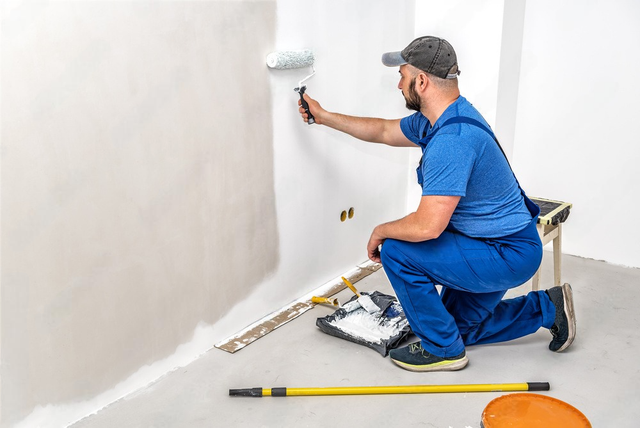Exploring the Various Kinds Of Paint: A Guide for each Task
Discovering the different sorts of paint is essential for attaining the desired result in any kind of project. From water-based choices that use ease to oil-based paints known for their toughness, each selection has its benefits. Specialized paints can include one-of-a-kind textures or finishes, while environment-friendly choices deal with those looking for sustainability. Comprehending these differences can substantially influence the success of a painting endeavor. What factors should one consider when making the best option?
Comprehending Paint Types: Water-Based vs. Oil-Based
Paint types can noticeably influence a task's end result, and recognizing the distinctions in between oil-based and water-based paints is necessary for notified decision-making. Water-based paints, commonly described as latex paints, are composed of water as the primary solvent. They dry quickly, produce fewer unpredictable natural compounds (VOCs), and are simple to tidy up with soap and water. This makes them a popular selection for indoor applications and atmospheres where air quality is a concern.
In comparison, oil-based paints make use of organic solvents, offering a durable, shiny surface ideal for surface areas subjected to tear and put on, such as trim and closets. They take longer to dry, call for mineral spirits for clean-up, and have a stronger smell. paint store corpus christi tx. Picking between these 2 types depends on the specific demands of the project, taking into consideration elements such as desired surface, application environment, and convenience of maintenance. Each kind has distinct benefits and limitations, assisting the selection procedure
The Finish Matters: Picking Between Matte, Satin, and Gloss
When picking a paint finish, the option in between matte and glossy alternatives significantly affects both looks and performance. Matte coatings offer a subtle, non-reflective appearance that can hide surface blemishes, while shiny finishes supply resilience and convenience of cleansing. Understanding the benefits and factors to consider of each can help in making a notified choice for any kind of painting project.
Matte Complete Advantages
Many property owners dispute the qualities of various finishes, matte paint provides distinct advantages that make it a popular choice for both interior and exterior applications. Among the primary advantages of matte coating is its capacity to conceal surface area blemishes, developing a smoother look on wall surfaces. This top quality is specifically useful in older homes or rooms with irregular surface areas. Furthermore, matte paint absorbs light instead of showing it, which can enhance the aesthetic of an area by giving an extra advanced and soft look. Furthermore, matte surfaces are frequently simpler to touch up than glossier alternatives, as they can mix a lot more perfectly when applied over existing paint. Overall, matte paint is a superb selection for those seeking an improved and sophisticated finish.
Shiny Complete Considerations
A shiny coating can substantially modify the perception of a room, using a reflective and streamlined high quality that enhances both color vibrancy and light within a room. This surface is frequently preferred for high-traffic locations and surface areas like bathroom and kitchens, where longevity and convenience of cleaning are crucial. Nevertheless, its reflective nature can highlight blemishes on walls, making appropriate surface area preparation important. Glossy paints likewise often tend to show fingerprints and smudges more readily, requiring normal upkeep. Additionally, lighting plays a considerable function; in intense settings, a glossy finish may produce glare, affecting the general visual. Cautious consideration of the particular application and atmosphere is essential when selecting a glossy finish for any project.
Specialty Paints: When to Make Use Of Distinctive or Chalk Paint
Specialized paints, such as distinctive and chalk paint, offer distinct aesthetic and practical benefits that can boost numerous surface areas. Textured paint is perfect for creating deepness and measurement on wall surfaces, concealing imperfections while including a three-dimensional feeling. It is particularly useful in high-traffic locations where durability and aesthetic passion are necessary.

Both sorts of specialty paints can change rooms, however choosing the right one depends on the wanted effect and surface area needs. Distinctive paint might suit bigger areas, while chalk paint can revitalize smaller sized items, showcasing creativity and personal style in any kind of task.
Outside Paints: Securing Your Surface Areas From the Components
Outside paints are vital for protecting surface areas versus different climate condition. Comprehending their climate resistance functions, proper surface area preparation needs, and effective application strategies can considerably enhance toughness and performance. This area will detail key factors to consider for selecting and making use of outdoor paints successfully.
Weather Condition Resistance Features
Weather condition resistance is an important attribute of outdoor paints, as it figures out just how well surfaces can stand up to the harsh aspects of nature. High-grade outdoor paints are developed to stand up to damage from UV rays, wetness, and temperature level variations. UV resistance guarantees colors stay vivid over time, stopping fading and staining. Dampness resistance protects against mold and mildew, which can jeopardize the honesty of surface areas. Additionally, paints with outstanding temperature resistance can acquire and increase without cracking, maintaining their protective high qualities. When choosing outside Related Site paints, it is crucial to think about these climate resistance attributes, as they add to the long life and durability of painted surfaces, making certain they remain aesthetically pleasing and functional despite direct exposure to the components.
Surface Area Prep Work Demands
Appropriate surface preparation is a fundamental action in accomplishing the most effective results with outdoor paints. To assure perfect bond and toughness, surfaces should be thoroughly cleansed, getting rid of dust, oil, and mildew. This can be accomplished making use of a pressure washer or a scrub brush with an ideal cleaning solution. As soon as cleaned up, surfaces need to be checked for any peeling or flaking paint, which have to be scuffed away to create a smooth structure. Repairing any kind of openings or cracks is additionally necessary, as these can allow dampness infiltration. In addition, sanding harsh areas advertises much better paint attachment. Using a guide suited for exterior use can improve the paint's efficiency, guaranteeing a resilient finish that stands up to the elements. Appropriate prep work is essential to an effective outdoor painting job.
Application Strategies Tips
While applying outside paints, it is necessary to use reliable techniques that guarantee surfaces are well-protected against the aspects. Initially, choose the best day for painting; low humidity and moderate temperature levels boost adhesion and drying. Prepping the surface completely-- cleaning, sanding, and priming-- makes sure much better paint attachment and durability. Using high-grade brushes or rollers can provide a smoother finish, while spray painting may cover large locations successfully. Using paint in slim, also layers stops runs and drips. It is a good idea to comply with maker directions relating to drying times between coats. Finally, validate correct air flow during application to help with drying and minimize direct exposure to fumes. visit their website These strategies considerably improve the longevity and effectiveness of exterior paint.
Eco-Friendly Options: Low-VOC and Zero-VOC Paints
As consumers become significantly knowledgeable about the environmental influence of their options, low-VOC and zero-VOC paints have arised as prominent choices. These paints are created to contain less unstable natural compounds (VOCs), which are chemicals that can evaporate right into the air and contribute to air contamination and health issue. Low-VOC paints usually contain a restricted amount of VOCs, while zero-VOC paints have minimal levels, making them much safer for both indoor and exterior use.
The benefits of using low-VOC and zero-VOC paints expand beyond ecological considerations; they likewise boost indoor air top quality, decreasing the threat of sensitive responses and breathing concerns. Many makers currently provide a selection of shades and finishes in eco-friendly alternatives, making it much easier for customers to find appropriate items for their tasks. By going with these paints, individuals can add to a much healthier setting while still achieving the aesthetic they prefer in their areas.
Devices and Strategies for a Flawless Application
Achieving a perfect paint application needs the right devices and methods, which can substantially enhance the outcome. Selecting the suitable brush or roller is vital; brushes function well for sides and complex areas, while rollers cover larger surface areas effectively. Using top pop over to this web-site notch products assures better paint distribution and decreases streaks. For optimal results, surface area preparation is vital. This includes cleaning, sanding, and priming surface areas to promote bond.
Strategy also plays a substantial duty. The "W" approach with a roller aids to uniformly distribute paint, while long, smooth strokes with a brush prevent noticeable lines. Operating in areas enables for better control and blending. In addition, using thin layers is better to thick layers, minimizing the danger of drips and uneven appearances. Keeping a wet side during application helps accomplish seamless adjustments between locations. By integrating these techniques and devices, one can accomplish a sleek and expert finish.
Tips for Preserving and Caring for Your Painted Surfaces
Correct maintenance and treatment of painted surface areas can greatly expand their life-span and preserve their look. Regular cleansing is important; making use of a soft cloth or sponge with moderate soap and water can get rid of dust and dust without damaging the paint. It is a good idea to avoid rough cleansers or scrubbing pads, as these can scrape the surface area. Additionally, applying a fresh layer of paint every couple of years can revitalize the shade and protect against wear.
For outside surface areas, inspecting for indications of peeling off or fading routinely is very important. Promptly dealing with any type of problems protects against further damage. In areas susceptible to wetness, such as washrooms, making use of mold-resistant paint and making certain correct ventilation can aid keep the integrity of the paint. Finally, making use of safety surfaces can protect versus UV rays and spots, ensuring that painted surfaces stay lively and attractive for several years ahead, inevitably boosting the total visual of the area.
Regularly Asked Inquiries
Can I Mix Different Kind Of Paint With Each Other?
Blending various kinds of paint is usually not advised, as it can bring about concerns like inadequate attachment, irregular structure, or unforeseen chain reaction. It's finest to utilize compatible paints for perfect results and resilience.

How Do I Appropriately Shop Surplus Paint?
To effectively store leftover paint, seal the container tightly, label it with the date and color, and keep it in an amazing, completely dry location far from straight sunshine and extreme temperatures for suitable conservation.
What Is the most effective Way to Deal With Unused Paint?
The very best way to deal with unused paint is to check local laws, as many areas have actually designated contaminated materials facilities. Additionally, consider donating useful paint to area companies or institutions for their projects.
How Can I Inform if Paint Is Still Good to Make Use Of?
To identify if paint is still excellent, examine its smell, color, and uniformity. If it shows up apart, has an unpleasant smell, or reveals significant modifications in appearance, it's likely no much longer useful.
Are There Age Restrictions for Getting Paint Products?
In many regions, there are no details age restrictions for buying paint items. Nonetheless, some stores may need consumers to be a minimum of 18 years old, especially for items containing solvents or dangerous products.
Paint types can significantly influence a task's end result, and recognizing the distinctions between water-based and oil-based paints is vital for educated decision-making. Water-based paints, often referred to as latex paints, are composed of water as the primary solvent. In contrast, oil-based paints utilize organic solvents, offering a resilient, glossy finish suitable for surfaces exposed to wear and tear, such as trim and cabinets. Specialty paints, such as distinctive and chalk paint, deal one-of-a-kind visual and sensible advantages that can improve different surfaces. In areas prone to dampness, such as washrooms, making use of mold-resistant paint and making sure appropriate ventilation can help keep the stability of the paint.